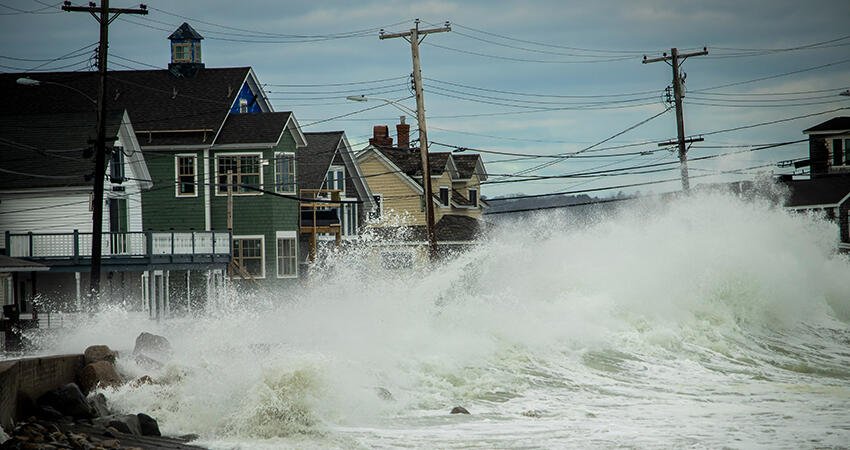
(Arthur Villator/Shutterstock)
Rising Sea Levels Are Threatening Affordable Housing. What Can Local Governments Do?
Rising sea levels is one alarming effect of climate change. Amid increasing greenhouse gas emissions, the global sea level has risen about 8 inches—a rate that’s doubled since 1993. A recent NASA study found that by 2050, the Gulf Coast and Southeast region will see the greatest rise in sea levels in the US, increasing 12 inches.
Coastal communities, especially those without adequate flood prevention strategies, are in more danger than ever. Racially segregated and economically disadvantaged communities within these areas face disproportionate challenges to combating sea level rise and maintaining safe, affordable housing. Local policymakers can combat sea level rise and protect vulnerable residents by determining their region’s flood risk and working with their communities to develop an equitable flood prevention and mitigation plan.
Coastal communities are already at risk
Coastal community residents with lower median incomes are already fighting the effects of climate change and facing displacement from flooding and inadequate infrastructure. A study found that “two feet of sea level rise will increase low-lying flooding by 700 percent in the most economically disadvantaged Black communities that often lack the resources to rebuild.”
In 2020, residents of Louisiana and East Texas, a racially segregated, climate-vulnerable region, faced the devastation of Hurricane Laura. In 2018, a predominantly Black community in the Gullah-Geechee Corridor (a long stretch along the Atlantic coastline) was forced to leave as their homes flooded from Hurricane Florence. And Hurricane Katrina, one of the most damaging disasters in the US to date, was catalyzed by sea level rise and displaced more than a million people. Four of the seven zip codes that experienced the costliest flood damage from Katrina had populations that were 75 percent Black.
America already has a shortage of at least four million homes, which disproportionately affects the communities most at risk of climate displacement. In 2021, NPR found that, in attempt to increase the affordable housing supply, the US Department of Housing and Urban Development was inclined to sell more homes in flood-prone Florida, Louisiana, and New Jersey to people with lower incomes, as those with greater financial flexibility try to avoid paying additional flood insurance. With less housing supply, states have also been considering investing in flood-proofing homes, rather than relocating those in flood-prone areas.
Thousands of homes along the coast are subject to flooding as sea levels rise, necessitating flood prevention strategies to preserve life, protect housing, and maintain affordability.
What can local governments in coastal regions do to combat rising sea levels?
Prioritizing solutions targeted at the most vulnerable populations who’ve continually experienced underinvestment will help ensure disparate outcomes don’t widen. Local policymakers can consider the following steps.
- Determine flood risk. Understanding their local threat level is the first step to addressing the problem. Local leaders can use data and tools from the National Oceanic and Atmospheric Administration, Federal Emergency Management Agency, and First Street Foundation to map community risk.
Develop resiliency with elevation. As sea levels rise, previously safe home systems may now be at risk of flooding. Thus, establishing grant programs to elevate utility systems above projected sea levels could help mitigate risk in coastal areas.
Both Norfolk, Virginia, and New York City adopted new zoning rules that require buildings at risk of flooding to meet flood-resistance standards. However, these policies may be structurally challenging to execute, as a bulk of New York’s housing stock is multifamily attached buildings, which are extremely difficult to raise (PDF). Iowa’s Flood Mitigation Program allowed Dubuque residents to elevate and upgrade parts of their properties, which decreased their emotional and financial burdens, as well as chronic flooding damage. Reorienting local budgets to invest in mitigation efforts and using federal funds could prevent more expensive repairs.
Create gray and green infrastructure. Sometimes, structural solutions such as dams, seawalls, roads, or water treatment plants are necessary to face rising sea levels. Gray infrastructure, such as stormwater pumps, which move floodwater from oversaturated city streets back to water sources, and raising roads can help reduce flooding.
Green infrastructure, or using natural elements like sand and vegetation to stop flooding, can also help. Cities such as Boston and Norfolk are employing waterfront protections, like parks and marshes that not only increase climate resilience but also create green community amenities for residents. The Ohio Creek Watershed Project (PDF) is attempting to combine both green and gray infrastructure, with a $130 million investment that includes elevating roads, installing a floodwall, creating rain gardens, and expanding wetlands.
- Implement zoning, buyout, and relocation programs. Local governments play a major role in determining land-use regulations and other programs that influence where people build and live in relation to water hazards. Cedar Rapids, Iowa, and Norfolk supported buyouts of vulnerable properties. The Quinault Indian Nation in northern Washington state is planning a managed retreat as they lose land to ocean encroachment.
Engage community members. Involving the residents most affected by disasters—especially those with low incomes and people of color—in each step of mitigation efforts is critical to ensuring equitable outcomes.
New York City’s new zoning rules included feedback from more than 200 public meetings over four years. And in a small, African American neighborhood in Raleigh, North Carolina, local lawmakers have integrated community (PDF) voices into their flood mitigation by creating a management advisory committee, and have aligned stakeholders on flood warning systems, a streamflow system and a housing development pause in the floodplain.
One cost-benefit analysis of flood mitigation efforts suggests the following best practices were for effective community engagement: early involvement, frequent interactions, tailored information sharing, and equitable provisions (such as offering child care and evening meetings). These practices supported developing flood mitigation plans.
Mitigation at the community and household levels can protect housing and preserve supply. To prioritize safety and equity in mitigation efforts, local policymakers can consider investing in targeted flood prevention in coastal communities of color and less-resourced communities to increase climate resilience for those who’d benefit most.


